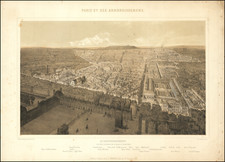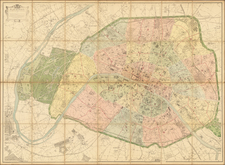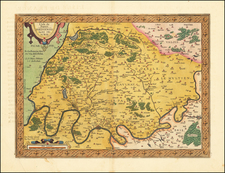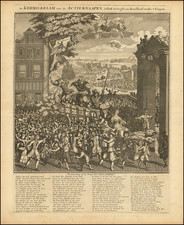Redesigning Paris Streets Around The Pantheon Under The Direction of Jacques-Germain Soufflot
Rare plan of the area around the Church of St. Genevieve, now the Panthéon, in the 5th Arrondissement in Paris.
The map offers an early template of the area which would be designed and re-designed over the next several decades, ultimately with the modificaiton of the church design to become what is now the iconic Panthéon of Paris.
The present map provides an overview of the area impacted by Louis XV's desire to create the Church of Saint Genevieve, replacing an ancient abby which occupied the site. For this purpose, the famed French architect Jacques-Germain Soufflot was commissioned to design the new church and modify the streets surrounding the area, a modernization project that would pre-date Haussmann's work by nearly a century.
On the map, in the area of the Church, the outlines of the older streets and buildings are shown in faint lines, with the modern plan shown and shaded to show buildings. Major landmarks include the Sorbonne, Place St. Michel, the Jardin de Luxembourg (at the lower left), and College de Navarre.
The Church of St. Genevieve was built using the designs of Jacques-Germain Soufflot, at the direction of King Louis XV of France. Commissioned in 1755, the church was built between 1758 and 1790. By the time of its completion during the French Revolution, it was repurposed as a mausoleum honoring French citizens, now called the Panthéon. Soufflot also redesigned the neighboring streets as part of the project.
Rarity
The map is very rare on the market. We note one example in a Parisian dealer catalog in 2003.
The map shows evidence of having gone through at least two print iterations, with the area around the Panthéon showing remnants of burnished-out engraving.
George-Louis Le Rouge (1712-1790), though known for his work in Paris, was originally born Georg Ludwig of Hanover, Germany. He grew up and was educated in Hanover, after which he became a surveyor and military engineer. Around 1740, however, Le Rouge moved to Paris and set up shop as an engraver and publisher on the Rue des Grands Augustins. It was at this time that he changed his name, adopting a French pseudonym that would later become quite famous.
Le Rouge spent much of his forty-year career translating various works from English to French, and his cartographic influence often came from English maps. His experience as a surveyor and engineer in Germany made him a skilled and prolific cartographer, and he produced thousands of charts, maps, atlases, and plans. His work spans from garden views and small-town plans to huge, multiple-continent maps. Le Rouge eventually accepted the position of Geographical Engineer for Louid XV, the King of France.
Later in life, Le Rouge became well-known for publishing North American maps, such as in his Atlas ameriquain septentrional of 1778. One of Le Rouge’s other more famous works is the Franklin/Folger chart of the Gulf Stream, which he worked on with Benjamin Franklin. Franklin and Le Rouge corresponded around 1780 and collaborated to create this map, a French version of Franklin’s famous chart which was originally printed in 1769.
Jacques-Germain Soufflot was a French architect in the international circle that introduced neoclassicism. His most famous work is the Panthéon in Paris, built from 1755 onwards, originally as a church dedicated to Saint Genevieve.
In the 1730s, Soufflot attended the French Academy in Rome, where young French students in the 1750s would later produce the first full-blown generation of Neoclassical designers.
After returning to France, Soufflot practiced in Lyon, where he built the Hôtel-Dieu. With the Temple du Change, he was entrusted with completely recasting a 16th-century market exchange building housing a meeting space housed above a loggia.
Soufflot returned to Rome in 1750 in the company of the future Marquis de Marigny, the talented young brother of Madame de Pompadour, who was being groomed for his future as director of the King's Buildings (Bâtiments du Roi). On this trip Soufflot made a special study of theaters. In 1755 Marigny, the new Director General of Royal Buildings, gave Soufflot architectural control of all the royal buildings in Paris. In the same year, he was admitted to the Royal Academy of Architecture. In 1756 his opera house opened in Lyon.
The Panthéon Soufflot's his most famous work, but the Hôtel Marigny built for his young patron (1768–1771) across from the Élysée Palace, is a better definition of Soufflot's personal taste. Soufflot died in Paris in 1780.
Like all the architects of his day, Soufflot considered the classical idiom essential. He stood out for his "strictness of line, firmness of form, simplicity of contour, and rigorously architectonic conception of detail" which contrasted sharply with the late Baroque and Rococo architecture of his contemporaries.










![[Anne Du Bourg Confront the King Henri II and the Parliament of Paris in June 1559] Der Parlements hern gem in rath Mercu rialle gen ant bein Kugusinern ou Paris. . .](https://storage.googleapis.com/raremaps/img/small/78594.jpg)



![[Paris Environs - Southeast] Carte Routiere pour Automobilistes & Cyclistes -- Environs de Paris Section Sud-Est](https://storage.googleapis.com/raremaps/img/small/95862.jpg)